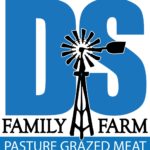Worried about what you are "really" eating? Have peace of mind with pasture grazed meats.
Hello FLERD!
FLOCK + HERD = FLERD
Earlier this spring, son Nathan purchased a small local flock of Katahdin hair sheep. We arranged with neighbors to graze the flock on their pastures while we upgraded our perimeter fencing to handle sheep. The ewes (females) went to one neighbor along with a couple of head from the beef herd. The ram (male) went to another neighbor’s pasture. The ewes came home in mid-September and yesterday the ram arrived.
Breeding Season
The experts will tell you that one of your largest costs to owning livestock is keeping your pregnant female animals fed and happy. To keep expenses low and animals healthy, it is best to mimic nature’s pattern. In our area, the wild deer (white-tails) breeding season is the first part of November. The female deer (doe) will start dropping fawns in May. If we can come close to mimicking how nature functions in this part of the world, we should be matching our pregnant female animal needs with our local forage growth cycle.
2024 will be our first year of lambing. If things work out, lambs will start arriving the first of April. Will that be too early in the growing season? From experience, we like our calves to start arriving mid-April. We will learn and adjust as needed.
Fence and Protection for Sheep
This past summer, grazing the sheep on green growing forages, we were able to keep the flock controlled with a single portable poly-wire electric fence. Now that our forages are going dormant for the year, a single poly wire does not keep the sheep contained. The flock is sticking close by to the cattle herd at this point. We hope the sheep continue to bond with the beef herd as we are counting on the cattle to protect the flock from any predators.
Mimicking Nature
In previous blog posts, we have tried to champion the idea that nature follows a created order. Humans are here to care for the earth, and work within its natural bounds. When we try to exceed those bounds, nature simply will not allow it. Pests and weeds will arrive to correct the mistakes imposed by human mismanagement. If something appears ugly, such as an erosion scar, nature will send weeds to cover and heal it. If something smells bad, such as ammonia coming from too many livestock in an area, nature will send pests and pathogens to try to disperse the animals. Nature loves and encourages balance, not excess.
We recognized that by only grazing cattle, we were not following nature’s pattern. Though cattle are a significant keystone species for managing grasslands, with only cattle, we were like a crop farm raising a single crop (mono-cropping).
We have a God of abundance expressed through diversity in His creation. In our effort to increase diversity, this past year we did a better job distributing our chicken shelters across the farm. Adding pigs last year brought some exciting diversity to our pasture-forest edges. Now with the addition of sheep, we bring new impact to the forbs and shrubs within our grasslands and are anxious to see how this impact will hopefully diversify our grasslands.









